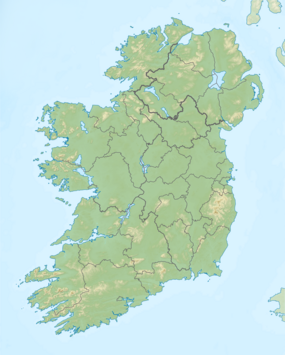New Grange
| Sí an Ḃrú | |
 |
|
| Location | County Meath, Ireland |
|---|---|
| Coordinates | 53°41′39.73″N 6°28′30.11″W / 53.6943694°N 6.4750306°WCoordinates: 53°41′39.73″N 6°28′30.11″W / 53.6943694°N 6.4750306°W |
| Type | passage grave |
| Width | 76 meters diameter (cairn) |
| Area | 1.1 acre (0.5 hectare) |
| Height | up to 12 meters |
| History | |
| Founded | c. 3200 BC |
| Periods | Neolithic |
| Site notes | |
| Excavation dates | 1962-75 |
| Archaeologists | Michael J. O'Kelly |
| Ownership | Office of Public Works |
| Public access | yes (guided tour only) |
| Official name | Brú na Bóinne - Archaeological Ensemble of the Bend of the Boyne |
| Type | Cultural |
| Criteria | i, iii, iv |
| Designated | 1993 (17th session) |
| Reference no. | 659 |
| Region | Europe and North America |
Newgrange (Irish: Sí an Ḃrú or Brú na Bóinne) is a prehistoric monument in County Meath, Ireland, located eight kilometers west of Drogheda on the north side of the River Boyne. It was built during the Neolithic period, around 3200 BC, making it older than Stonehenge and the Egyptian pyramids. The site consists of a large circular mound with an inner stone passageway and chambers. Human bones and possible grave goods or votive offerings were found in these chambers. The mound has a retaining wall at the front, made mostly of white quartz cobblestones, and is ringed by engraved kerbstones. Many of the larger stones of Newgrange are covered in megalithic art. The mound is also ringed by a stone circle. Some of the material that makes up the monument came from as far away as the Mournes and Wicklow Mountains. There is no agreement about what the site was used for, but it is believed that it had religious significance. Its entrance is aligned with the rising sun on the winter solstice, when sunlight shines through a 'roofbox' and floods the inner chamber. Several other passage tombs in Ireland are aligned with solstices and equinoxes, and Cairn G at Carrowkeel has a similar 'roofbox'. Newgrange also shares many similarities with other Neolithic constructions in Western Europe, such as Maeshowe in Orkney, Scotland and Bryn Celli Ddu in Wales. It is the most famous monument within the Neolithic Brú na Bóinne complex, alongside the similar passage tomb mounds of Knowth and Dowth, and as such is a part of the Brú na Bóinne UNESCO World Heritage Site.
...
Wikipedia

